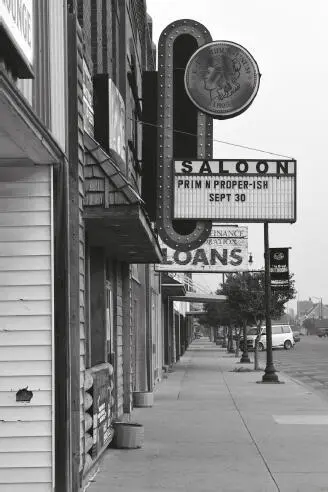By morning on my second day at Standing Rock, a cloud of smoke from the Montana fires settles like a thick fog over the entire area. I can no longer see the rolling meadows stretching to the Missouri River, much less the expansive bridge that spans it. Beads of headlights travel on a slim thread of road moving across the reservation. I join the line of cars leaving the reservation and heading into Mobridge – a town that was built on land taken from the Lakota Sioux in 1906 for the construction of a railroad.
In Mobridge I find a gas station – and things quickly become confusing. The pump has a range of five options, all with various grades of ethanol. I have no idea which one the rental car needs and no way to make sense of all of the choices. I wait as an older white man washes the windshield on a woman’s truck; as he works, he calls out to everyone entering the station by name. The white woman behind the wheel of a very tired-looking Ford engages him in easy banter. It was a banter that I came to recognize as both a kind of community and a kind of wall. The banter isn’t open to everyone. I would bump up against it many times when dealing with white people in the area. After some time, I signal and make it clear that I’m waiting for help. In return they both look away, making it equally clear that they would finish their conversation without hurry. When the woman finally starts her engine and pulls away, I still seem to be invisible to the attendant and so I ask for help. Without a word, and without looking at me, the man picks up the nozzle for the 87 octane and begins to fill my gas tank. Then, with a sweeping gesture toward the gas pumps, says: “These are a gift from your Black president. Or I should say your former Black president.” I wonder how this older, white man sees me.
When I want to convey a sense of ease that I really don’t feel, as I did in this moment, I imagine someone I love before speaking. I smiled and shifted my weight to a relaxed posture. But then out of my mouth comes:
“What gifts are we getting from your white president?”
“Oh, so you’re going to be like that.” He takes a step back. Obviously, my smile isn’t always enough. But the exercise is helpful, and I don’t give up easily on the strategy.
“No, no,” I laugh. “I asked because of how you said it. Are you a Trump fan?”
“Definitely not. That election didn’t give us any choices. I know some think she would have saved the world. That woman is just … well, let’s just say neither one of them are looking out for us. They keep getting richer and you and I keep getting poorer. Nothin’ going to change that.” Maybe my strategy has worked. I seem to be on his side of the fence now. I don’t know how this happened but I’m grateful. I take care not to mention the name of “that woman” (Hillary Clinton) in our conversation about politics.
There are two main roads in Mobridge, one that is a throughway for traffic heading in and out and another that resembles the sleepy main streets of business districts in many midwestern towns. It’s about 10:30 in the morning when I drive down the main street in Mobridge. It’s a few blocks long and mostly empty, except for a string of pickup trucks parked in front of a local bar.
In my phone calls home, my family complain about the photos I send them: “Why don’t you take photos of places that have people in them?” The truth is that in struggling communities a lack of disposable income can make a town feel completely empty. This is certainly the case in Mobridge. Although noticeably larger and wealthier than the towns on the reservation, it is also clearly a struggling community. Most of the businesses are shuttered. The storefronts that are open do double duty: a single storefront serves as a craft shop, a florist, and a café. There are no bookstores, department stores, movie theaters or bowling alleys. As is typical among the Midwest towns I visited, the Ace Hardware store is the largest and most well-kept building in town.

Downtown Mobridge, South Dakota.
Mobridge is remarkable in that it has a restaurant and two full-size grocery stores. I shop in both on weekday afternoons and find that I am the only woman unaccompanied by a man as I wander the aisles. All of the women appear to be shopping with their husbands. In a town where everybody seems to know everybody else, I stand out – perhaps for more reasons than I can imagine. In the dairy section, I stand for a moment staring at an ordinary pound of butter that sells for $6.50. I can’t help but wonder why, after all of these years, I still expect groceries to be less expensive in poor communities. It has never been the case. The butter here is more expensive than in Whole Foods in Washington, DC. In this rural South Dakota community produce is more limited and less robust than in the DC area, and there are fewer options on the shelves. Add to these difficulties the fact that people on Standing Rock have to travel thirty or forty miles one way for a weekly shop. I wonder what that trip would be like in a South Dakota winter.
The next day I drive out to McLaughlin. Routes 12 and 9 intersect in McLaughlin and the intersection has the bustle of an agricultural hub – grain silos and massive trucks sit just off the crossroads. The town’s main street is a couple of blocks long, and is home to a small café, a gas station, and a senior center. McLaughlin has a population of about 670. In the 2010 census, white people were almost one-third of the population; by 2019 that number had fallen to 25%. Although a lot of Native people live there, there is an overwhelming presence of white people that makes McLaughlin feel like a white enclave on the reservation. Unfriendly doesn’t begin to capture the feeling I get from other white people in the town. White people consistently dismiss my interest in the place, interrupt my conversations with Native people, and question me intently. I am too far outside of local culture to understand any of this with confidence, but it surely stands out in my experience.
At the local senior center, I am greeted by an older white woman who sits at a Formica table. All four walls of the faux wood paneling have been covered with lacquered jigsaw puzzles completed by people who attend the center. As I quickly survey the room, I notice that the clock is one hour behind the time on my phone. When I ask her about this the woman explains: “No it’s not behind. We use Mountain time here.” A simple enough statement but said with such intensity that it seems to have a pointed significance that I don’t understand. Later, in Fort Yates, Two Lance Woman explains: “Only white people use Mountain time,” she tells me. “Indians do not recognize the Mountain time zone – everyone on the Cheyenne and Standing Rock reservations uses Central time.” This was the point the woman in the senior center was making. White-people time. It’s a very intentional assault on Native sovereignty even from within the borders of the reservation.
Ellison Thompson is a Lakota woman who lives in McLaughlin. She and her husband were both unemployed when she got pregnant. That’s when they made a deal that whoever got a job first would take it – the other, by necessity, would be the stay-at-home parent when the baby came. Ellison got the first job; her husband is now a stay-at-home dad caring for their ten-month-old baby. With a second child on the way this arrangement is unlikely to change. Ellison would like to go to back to school to complete a degree but there’s never enough time for everything that needs to get done as it is.
Читать дальше













